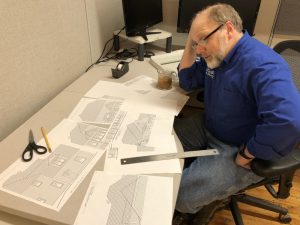Last month we covered the fifth and final stages of a solar installation, the Closeout Stage, meaning we started at the end. So what are the other four stages?

Well, it all starts with the Sales Stage (what we call the paperwork chase), then Engineering, Operations, and finally Installation.
We’ll cover the Sales and Installation stages eventually, but why don’t we jump right into the middle of it – Engineering & Operations? The two are distinct steps, but they are closely related and as “middle children” perhaps they often get overlooked despite their importance.
Let’s jump in.
As I noted above, Engineering & Operations comes after the paperwork chase that is the Sales Stage. The point where, as we say in the office, everything has been signed. But what really has to happen next after the signatures have dried? Well, it’s quite a lot actually.
In the Engineering Stage we need to confirm that the plan you and your solar consultant cooked up will work. That’s not to disparage your consultant’s fine work, but there is a lot more to it than meets the eye. So while in many cases the measurements and approaches that were taken during your initial site assessment will be obvious via satellite and pictures, we will often have to send someone out to confirm the data previously collected. Think of it as a “measure twice, cut once” type of process. That’s obviously doubly true if your initial proposal was done 100% remotely.
In short, we know it is a pain to have us come out twice, but it’s far better than having a crew show up with a set of system components that won’t fit. And in many instances, the second visit can actually be totally external to your home. Meaning, we just need to get up on the roof to measure as hopefully everything we need to learn about your home or building inside was gathered – along with pictures – during your site visit.
Beyond measuring twice, we also need to check your roof’s capacity to handle the array’s weight. In truth, solar panels don’t really weigh all that much, but here in New England snow loads are important. And in the last 15 years or so the standard “snow load requirements” in most towns has been increased substantially.
So while your home or business may have never had an issue with snow, the panel weight may mean the roof is not up to the current code once the new panels are taken into consideration. In that case we can’t get a permit unless we can get it up to code.
Engineering thus also means we need to get a licensed engineer’s opinion. To do that, we send out all the data and pictures we gathered and the engineer sends us back their analysis in a form we call a “Permit Packet”. That packet spells out in engineering terms what we’re going to build and most importantly if the roof will handle the load. And if not, what we need to do to ensure that it does. In addition, engineering includes the electrical “one line”. A term that implies a diagram of how the whole system will be wired and tied into your electrical system and the grid. Without it, we can’t get a permit to proceed.
Of course, in most homes the roof will be totally fine “as is”. But if it isn’t, the engineer will normally explain what type of reinforcements we need to meet your town’s requirements. And better still, for a standard home we can normally do those reinforcements at no additional cost. But of course, that can vary depending on your home or building so if your roof structure is unique (or it is a commercial building) we’ll work with you to see what needs to be done so we can still make a system install possible.
After Engineering we roll into the Operation Stage. So what does that mean?
Well, so now that we have a system we know we can build, and a roof we know can build it on, we can now file paperwork with all the various authorities (typically your town and utility), and submit purchase orders and the like for all your equipment. And in some places like RI there are sizing constraints that make the utility process even longer and more difficult (in some cases) to get around. This surprises some folks, but yes we can’t control the utility and we do order equipment specific to your project. The Operations Stage thus ends when we get all the approvals and have confirmed a delivery date for your materials. Only then are we ready for the last step to schedule the main event – the actual installation.
A topic we will cover next time!
If you like this article, you may also like:





No comments yet. You should be kind and add one!
The comments are closed.